Inside AFP
Journalists killed and injured in Lebanon: AFP's investigation points to Israeli army
An Agence France-Presse investigation into the strike in southern Lebanon on October 13 that killed a Reuters journalist and injured six others, including two from AFP, points to a tank round used only by the Israeli army in this high-tension border region.
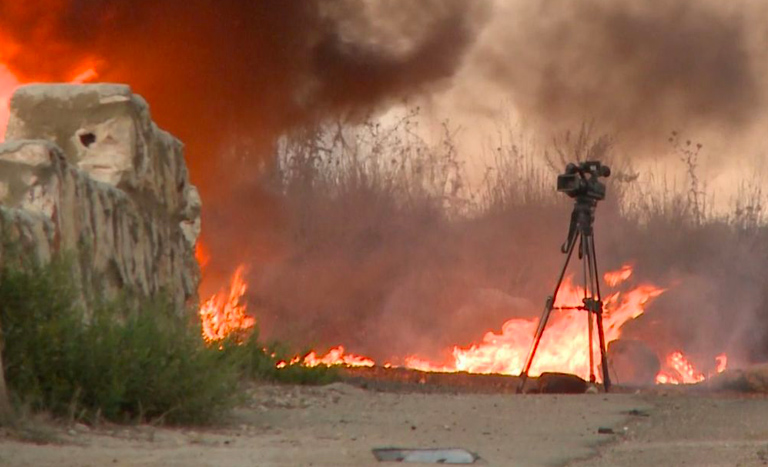
(© Courtesy of Al Araby)
Download the full report (PDF)
On October 13, two successive strikes hit a group of journalists near the Lebanese village of Alma al-Shaab as they were filming cross-border clashes between the Israeli army and armed groups in southern Lebanon.
Reuters journalist Issam Abdallah, 37, was killed instantly. Two more from Reuters, two from Al Jazeera and two from AFP, were injured. AFP photographer Christina Assi, 28, later had a leg amputated and remains in hospital.
A seven-week investigation conducted by AFP in conjunction with Airwars, an NGO that investigates attacks on civilians in conflict situations, points to a tank shell used only by the Israeli army in this high-tension border region.
Its evidence – combining expert munitions analysis, satellite images, testimonies and video recordings filmed before and during the attack – points to three key conclusions:
- The munition that killed Abdallah was a 120-mm fin-stabilised tank shell of Israeli origin that is not used by any other groups in the region.
- The strikes were deliberate and targeted. They arrived within 37 seconds of each other and just a few metres apart. The journalists were clearly identified as press, away from any military activity. The Israeli army has extensive aerial surveillance resources in the area.
- The strikes likely came from southeast of the journalists’ position, apparently near the Israeli village of Jordeikh where Israeli tanks were operating.
Separate investigations by leading rights groups Amnesty International and Human Rights Watch (HRW), each of which involved the verification and analysis of more than 100 videos and photos, corroborated AFP’s finding on the type of munition used in the first strike and the area from which it was fired.
HRW concluded that the strikes were “apparently deliberate attacks on civilians, which is a war crime” and which “should be prosecuted or may be prosecuted for war crimes.” Amnesty said the strike was “likely a direct attack on civilians that must be investigated as a war crime”. Lebanese authorities have called the attack a “deliberate killing” by the Israeli army.
Lebanese Prime Minister Najib Mikati said Thursday in a statement his government would “take all measures to include” the conclusions of the investigation “in the complaint filed before the UN Security Council”.
An Israeli military spokesman said after the strike: “We are very sorry for the journalist’s death”, adding that Israel was “looking into” the incident. In a statement on Friday, the Israeli army said "the incident is currently under review." "The area is an active combat zone, where active fire takes place and being in this area is dangerous," it said.
“AFP has been very clear that we will take all judicial avenues that we deem relevant and possible to ensure that we can get justice for Christina and Issam,” said Global News Director Phil Chetwynd, adding it was “absolutely essential that we have answers from Israel.”
“As soon as this incident happened, we asked Israel to conduct a thorough investigation into exactly what happened. Two months later, we are still waiting for answers,” he said.
EVENTS OF OCTOBER 13
Al Jazeera correspondents Carmen Joukhadar and Elie Brakhya were the first to arrive on the scene at around 16:30, following news of bombardments near Alma al-Shaab, a Lebanese village separated from the Israeli town of Hanita by the “Blue Line”, a demarcation line monitored by the UN.
Lebanon’s Hezbollah and local branches of Hamas and Palestinian Islamic Jihad had been exchanging fire with Israel on a near-daily basis across the border since Gaza-based Hamas fighters carried out their attacks on October 7. More than 110 people have been killed on the Lebanese side, mostly Hezbollah fighters, as well as more than a dozen civilians, according to an AFP tally.
Israel says six of its soldiers have been killed.
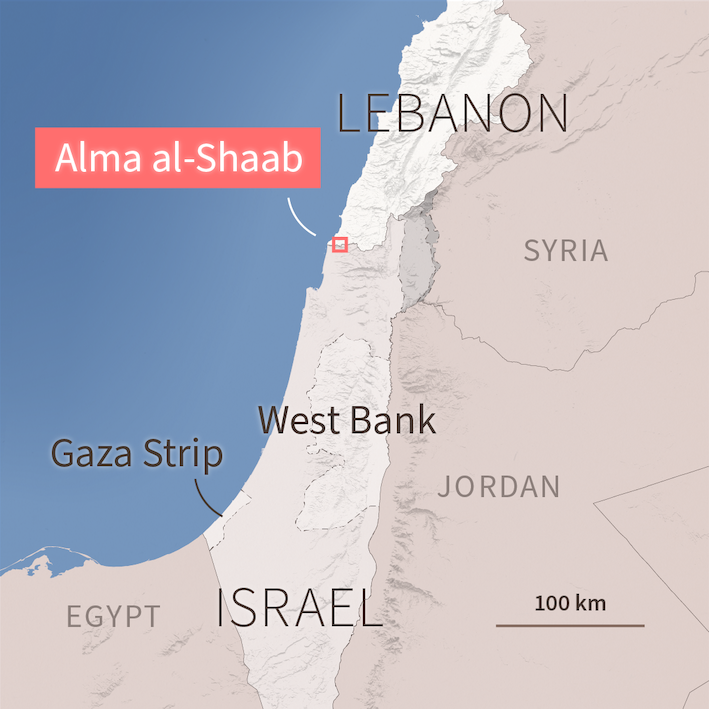
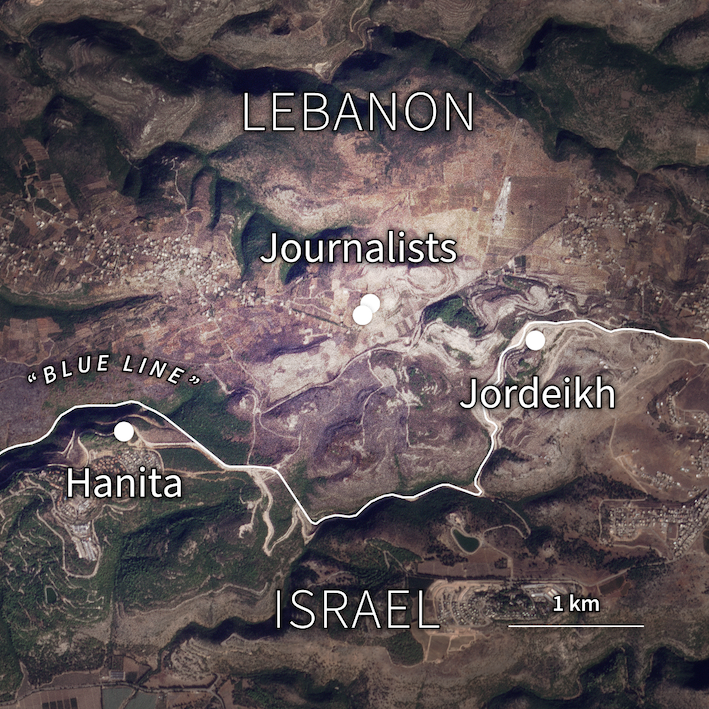
PLANET LABS / AFP / OSM
The day started relatively quietly around Alma al-Shaab, but shortly before the arrival of the two Al Jazeera journalists, local media reported an attempt to infiltrate Israel. The Israeli bombardment seems to have begun in response to this. Israel's army said in a statement it was carrying out artillery fire on Lebanese territory after “an explosion on the border fence” at Hanita.
The Al Jazeera team was joined 30 to 40 minutes later by AFP journalists Dylan Collins and Christina Assi, and Reuters journalists Issam Abdallah, Thaer Al-Sudani and Maher Nazeh. Also present was a team from Lebanese TV channel LBCI, positioned about 100 metres from the rest.
They began filming as the sun was setting, standing on a small road at the top of a hill, as shown in a video shot by AFP’s Assi on her phone and posted to her Instagram account shortly after 17:00. All were equipped with helmets and bulletproof vests marked “Press” and were standing behind cameras placed prominently on tripods. Her footage shows columns of smoke rising from the wooded valleys to the southeast and southwest of Alma al-Shaab, which is around 1.2 km from the border.
“I was live to report the Israeli bombardment, and I had just said that there was no rocket fire from the Lebanese side. We were all on a hill in an open-air area, without any rockets or military sites near us. There was nothing near us,” Al Jazeera’s Joukhadar told AFP.
Al Araby / Compte X Christina Assi / LIVE AFPTV
In the hour that followed, the bombings intensified. At least 20 apparently Israeli strikes targeted southern Lebanon, the closest landing about a kilometre from the journalists, according to AFP’s analysis of videos from several media outlets.
Footage also shows a helicopter on the Israeli side of the border, and at least one drone is heard flying a short distance from the journalists. A French military expert told AFP these tactical drones “fly low and at slow speed” and are used for “both surveillance and target guidance”.
“We had spent about an hour filming a distant pillar of smoke to our south, and some limited Israeli shelling along hilltops to our southeast. Just before 18:00, we turned our cameras towards the west and suddenly we were hit. It came out of nowhere,” said AFP video journalist Dylan Collins.
The first strike hit at 18:02. It killed Abdallah instantly and seriously wounded Assi. On the AFP video, she is heard screaming: “What happened? What happened? I can’t feel my legs.”
“We were in an exposed area, all of us wearing our helmets, our vests, just doing our job… and we were maintaining a safe distance from the front line,” said Assi. “Suddenly, everything became white… and I lost sensation in my legs, and I started crying for help.”
Collins attempted to provide her with first aid, but 37 seconds later, a second explosion occurred, this time hitting the Al Jazeera car located a few metres away. Collins, who had been attempting to place tourniquets on Assi’s legs, was wounded.
First strike at 18:02:14, second strike at 18:02:51.
Top: images from AFPTV camera (right: live broadcast, stopped after the first strike; left: recording from camera's memory card, which stops during the second strike).
Bottom left: LBCI recording, Bottom right: Dylan Collins' smartphone. AFPTV / LBCI
FINDING 1: AN ISRAELI TANK SHELL
A large munition fragment was filmed close to Abdallah’s body immediately after the strike. The day after, a local resident, who did not wish to be named, recovered the fragment and took photos of the scene.
AFP and Airwars had these pictures analysed by six weapons experts, including former British army officers and experienced conflict zone investigators. All agree that it was part of a 120-mm fin-stabilised tank shell, typically used by the Israeli army on its Merkava tanks. No other military group or organisation in the region uses this type of munition, the analysts said.
“This is the remnants of a tank round, clearly from a Merkava tank,” said one of the experts, Chris Cobb-Smith, a security consultant and former British army artillery officer.
“It's quite obvious to me because you can see the grooves on the round itself, which indicates it comes from the fin-stabilised family of munitions. When fired, some fins spring out of the back of the round [to] stabilise it in flight, which makes it much more accurate and increases its range,” added Cobb-Smith, who has extensive experience with this type of munition, including with fragments found during the 2008 and 2012 wars in Gaza.
Airwars reconstitution - AIRWARS AND AFP
Independent investigations carried out by HRW and Amnesty International reached the same conclusions, pointing to the use of a 120-mm tank shell of Israeli origin.
The experts identified three possible Israeli-made models, all of which have the same tail fins and can be fired from Merkava 3 and 4 tanks.
The Lebanese judiciary is in possession of fragments from the scene and has opened an investigation to determine the exact circumstances of the incident, but has yet to release its conclusions. However, a judicial source and two Lebanese military sources told AFP they had established that Israeli tank fire was responsible for the first strike, without giving further details.
FINDING 2: FIRED FROM ISRAEL
The investigation by AFP and Airwars has identified two Israeli positions from which shells were being fired that afternoon.
At the time of the strikes, the journalists had their cameras pointed southwest, toward a base near the Israeli town of Hanita. Images shot by Collins 45 seconds earlier show a projectile flying through the air but headed towards a distant point in the Lebanese hills. A closer shot by Reuters shows more clearly a tank firing then immediately changing position behind some vegetation.
.
Projectile fired from the position near Hanita 45 seconds before the fatal strike.
Left: AFPTV Live video, right: Reuters
AFPTV / REUTERS
In contrast, the projectile that struck the journalists is neither seen nor heard in any of the video recordings. It hit the journalists from the side — not from the front — as indicated by the orientation of the debris from the wall near Abdallah, which spread from east to west over around 10 metres. Military experts have told AFP that the way the debris was distributed indicated that the strike came from the east.
The likely source was the Jordeikh area to the southeast. Around 45 minutes earlier, the AFP video camera was pointing in this direction and the sound of at least one strike can be heard, followed by a plume of smoke rising from this position, indicating the presence of an Israeli tank.
Two witness statements support this direction of fire. A resident of Alma al-Shaab told AFP on condition of anonymity that he had seen “two straight red lines” resembling “missiles” appearing to be fired from the southeast just after 18:00. His story was corroborated by another resident who came to help the journalists after the attack.
Dispersion of debris from the wall hit by the fatal strike at 18:02 indicates a shot from the southeast. 45 minutes earlier, journalists captured a shot from the same direction, near the village of Jordeikh.
PLANET LABS PBC / AFPTV / AIRWARS
Satellite images from that morning and the following day, seen by AFP, show the presence of Merkava-type tanks very close to Jordeikh. Although it has not been possible to identify precisely which tank fired on October 13, their geolocation fits with the trajectory for the shell that hit the journalists, as shown in a reconstruction by Airwars.
AFP has not been able to access debris from the impact of the second strike, which caused the engine of the Al Jazeera car to explode, forming a crater. The direct hit on the front left side of the vehicle, which spun it around 90 degrees, suggests that the projectile came from the same direction as the first, i.e. the southeast.
Images of the damage and crater caused by the strike on the Al Jazeera car. AFP
The available evidence allowed for less certainty on the weapon used for the second strike. The experts say it may have been another tank round, or possibly a drone or even helicopter strike.
FINDING 3: TARGETED STRIKES
All the experts agree that the two strikes occurred 37 seconds apart, at a distance of only four or five metres, excluding the possibility of an accidental attack. They believe the strikes were deliberately aimed at the same target.
“Anyone who suggests this was an accident or mistake would have a lot of convincing to do,” said a former European military officer who has worked for decades on munitions analysis.
“One round clearly hit the cameraman directly, and the second round hit their vehicle… So I think we can discard the [idea] that this is in any way a random shot, or an unlucky shot,” added Cobb-Smith. “In my assessment, those individuals were targeted.”
The hill was not chosen randomly by the journalists. Its height offered a wide vantage point to follow the exchanges of fire, and appeared to be a safe location where they could be easily identified as press.
“I have known this hill since 2006,” Al Jazeera’s Elie Brakhya told AFP. “It is not covered in trees, it cannot be seen as suspicious. It would be difficult to have any military site there. It is a hill with two houses, nothing can be hidden there.”
Edmond Sassine, one of the journalists for the Lebanese TV station LBCI positioned around 100 metres down the hill, said the group was easily identifiable.
“We could see them with the naked eye… They were wearing protective clothing, they were clearly journalists,” Sassine told Reporters Without Borders. AFP’s Collins said Abdallah had taped a yellow sign reading “TV” to the bonnet of the Reuters car that afternoon.
Collins has no doubt that the Israelis knew they were journalists.
“I think from the moment that we arrived, the Israelis knew we were there,” he said. “We were exposed to several Israeli positions along the border, to the west and the east. They had drones there the entire time, they could probably see our faces.”
The testimonies of several journalists, corroborated by video recordings, make clear that there was no military activity in the immediate vicinity in the hour preceding the attack.
Automatic weapons fire can also be heard immediately prior to the first strike on the journalists. An audio analysis commissioned by Human Rights Watch found this shooting was several hundred metres away from their cameras.
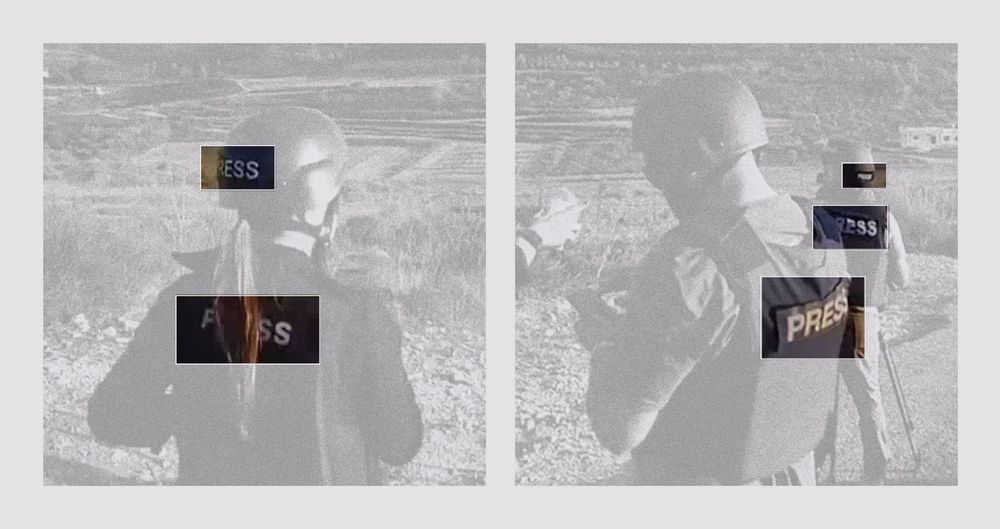
Helmets and bulletproof vests with clear “Press” markings worn by the journalists, visible in the video posted by Christina Assi on X. CHRISTINA ASSI, X
The investigation sought to establish whether the journalists could have been mistaken for fighters belonging to one of the armed groups active in the region.
Expert Cobb-Smith said this was unlikely given “the sophistication and the capabilities of the surveillance assets of the Israeli army.”
The journalists “were not operating in a military style,” he added. “They were standing out in the open, they had cameras on tripods, they were operating overtly, so one has to question why they were engaged by an armament of this capability.”
Amnesty’s investigation found the journalists had taken all necessary precautions to identify themselves.
“The Israeli military either knew or should have known that the seven individuals were journalists, and yet they still targeted them not once but twice, and therefore Amnesty is saying this is likely a direct attack on civilians and must be investigated as a war crime,” Aya Majzoub, Amnesty’s deputy regional director for the Middle East and North Africa, told AFP.
HRW said its own investigation concluded that the two strikes were “an apparent deliberate attack on civilians and under international humanitarian law, all parties to a conflict are obligated to only target combatants and not civilians.”
“Individuals who commit serious violations of the laws of war, with criminal intent, that is either intentional or recklessly should be prosecuted or may be prosecuted for war crimes,” added the group.
PREVIOUS ISRAELI ATTACKS
The AFP investigation was unable to determine which military unit was involved or what level of command gave the order to shoot. This investigation does not speculate on any possible motivations which could have led the Israeli army to deliberately target a group of journalists.
A separate investigation, published by the Reuters news agency on Thursday, also points to Israeli tank fire. Reuters worked with the Netherlands Organisation for Applied Scientific Research (TNO), an independent institute that tests and analyses weapons and munitions. The laboratory tested a remnant provided by Reuters and found that it was of a 120mm tank round.
TNO also analysed the audio from Al Jazeera’s live feed of the firing and impact of both rounds, as well as footage from Italian broadcaster Rai that captured the second round’s launch.
The findings established that the rounds were fired from a distance of 1.34 kilometres. Their sound signatures are identical, showing both rounds were fired from the same position, which TNO estimated to be in the Israeli outpost of Jordeikh.
“The evidence we now have, and have published today, shows that an Israeli tank crew killed our colleague Issam Abdallah,” Reuters Editor-in-Chief Alessandra Galloni said.
Several similar incidents have taken place in the region in recent weeks, as journalists broadcast live footage of clashes with Israel.
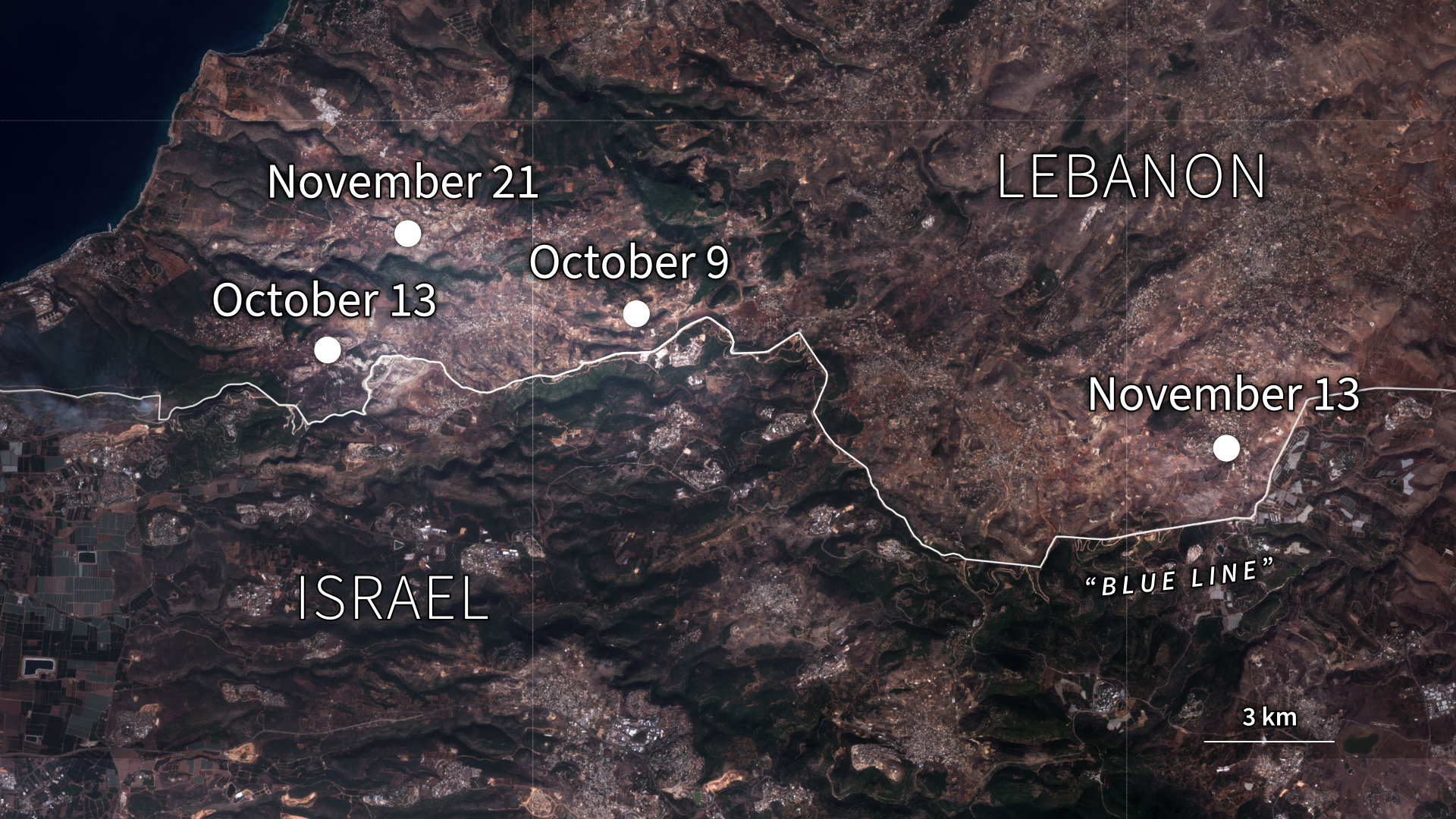
An Al Jazeera journalist was injured on November 13 by Israeli fire while he and other correspondents were covering bombardments in the region, near cars marked “Press”.
On October 9, a strike fell a few metres from an Al Jazeera team in Marwahin, another border town in southern Lebanon.
On November 21, two journalists from the pro-Iranian channel Al Mayadeen were killed along with a civilian in Israeli strikes on southern Lebanon. Lebanese Prime Minister Najib Mikati expressed his “strong condemnation” of the incident, saying Israel’s “aim is to silence the media who expose its crimes and its attacks.”
Al Jazeera said it “strongly condemns” what it called the “deliberate targeting of journalists in southern Lebanon by Israeli forces.”
The channel urged the International Criminal Court to “hold Israel and its military accountable for these heinous crimes.”
A spokesperson for Reuters said it was “shocking that a group of clearly identified journalists could be hit by fire in this way.”
The news agency reiterated its appeal to the Israelis to conduct their own probe. “It has been nearly two months since we called for them to investigate, and we have heard nothing since.”
“About as many journalists have died in the past two months as were killed in the entire 20 years of conflict in Afghanistan,” said AFP’s Chetwynd.
“We cannot allow such a culture of impunity to develop and it is absolutely essential that we rally as an industry to ensure that something is done about this.”
As of December 6, the Committee to Protect Journalists said at least 63 journalists and media workers had been killed since the start of the war on October 7.
Download the full report (pdf)
Crédits
The research for this report was coordinated by Jean-Marc Mojon, deputy to the global editor-in-chief and global news safety manager.
Production was coordinated by Sophie Huet, global editor-in-chief.
The research was also conducted by Celia Lebur, reporter at AFP’s international hub in Paris, and Rouba el-Husseini, Beirut-based reporter and Middle East investigative projects coordinator, with the Beirut bureau headed by Acil Tabbara.
Daphne Benoit, head of the international hub in Paris, Marc Jourdier, Jerusalem bureau chief, Khaled Soubeih, head of the Arabic-language digital investigation department, Gregoire Lemarchand, digital investigation editor-in-chief, Alexis Orsini, digital investigation journalist based in Paris and several other people within the agency’s network contributed to the research.
Frederic Bourgeais, design coordinator, led graphics and interactive production. Laurent Kalfala, innovation and visuals project manager, Clara Morineau, motion designer, and Simon Malfatto, deputy head of the graphics department, also contributed. The video versions of AFP’s investigation included in this report were edited by Charlotte Houang and Margarita Gorovine, Guillaume Meyer, video editor-in-chief, and his deputy Charlotte Turner.
Eric Randolph, Paris-based journalist, Chris Otton, deputy global editor-in-chief, and Richard Carter, bureau chief in The Hague, Jo Biddle, Middle East and North Africa editor-in-chief, and Francois Ausseill, Paris-based editor, contributed to the editing.
Agence France-Presse would like to thank Christina Assi, who is still in hospital in Beirut, and Dylan Collins for their testimonies, as well as all the other journalists wounded on October 13 and their employers for their cooperation and the material they made available to support this investigation. AFP would also like to thank Airwars, whose research and expertise provided the backbone of this report, as well as Amnesty International and Human Rights Watch for their dedication and cooperation.